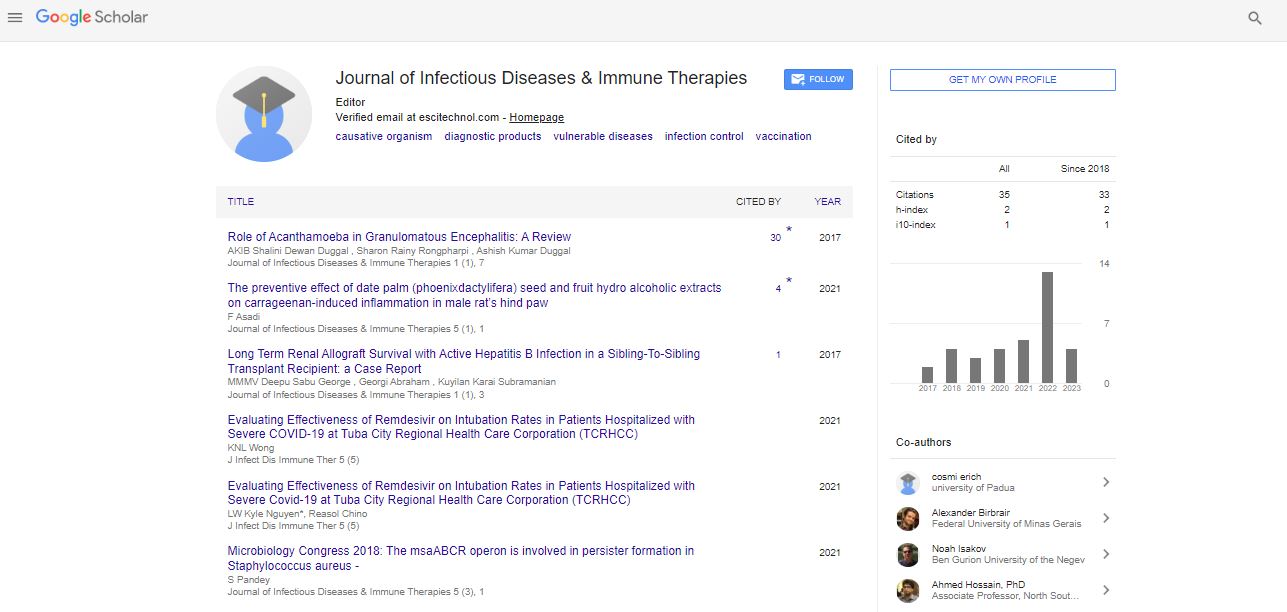Commentary, J Infect Dis Immune Ther Vol: 5 Issue: 6
Significance of Acanthamoeba in Granulomatous Encephalitis
Bunkechukwu Mehemed*
Department of Infectious Etiology of Chronic Diseases, Elizade University of Ilara- Mokin, Ondo, Nigeria
*Corresponding Author: Bunkechukwu Mehemed, Department of Infectious Etiology of Chronic Diseases
Elizade University of Ilara-Mokin, Ondo, Nigeria
E-mail: mehemed@kuw.in
Received: August 13, 2021; Accepted: August 27, 2021; Published: September 03, 2021
Citation: Mehemed B, (2021) Significance of Acanthamoeba in Granulomatous Encephalitis. J Infect Dis Immune Ther 2021, 5:5
Keywords: amphigoric organisms ,Acanthamoeba, T2 hyper intensity.
Description
Acanthamoeba are free-living amoebae that have attracted a lot of attention in recent years because of their capacity to cause devastating infections in immune compromised patients. Wearers of contact lenses, their function in various ecosystems, and their ability to act as a microbial pathogen host/reservoir and as a model organism for motility study. These are aerobic mitochondria-bearing cells. As amphigoric organisms, Acanthamoeba spp. They can live as free- living organisms, saprobes, or parasites in various environments. animals. Acanthamoeba has been classified under super group amoebozoa of the new schema of the Eukaryotes. It belongs to the Centramoebida clade of class discosea of the subphylum Lobosa. Lobosa consists of non-flagellate lobose amoebae; those with tube- shaped pseudopodia are grouped in class Tubulinea while those with flattened cells and different means of locomotion are grouped in class Discosea. More than 24 species of Acanthamoeba have been identified based on morphology. Acanthamoeba species most commonly associated with human infections are A. castellanies, A. Culbertson, A. hatchetti, A. Healy, A. astroonyxix, A. divineness and A. polyphagia. These species were initially categorized into three groups based on their morphology and cyst size. Later identification was done on the basis of sequencing of the amoebae 18S rRNA genes and 17 different genotypes (T1–T17) of acanthamoeba were established. The genus Acanthamoeba comprises of several species of free-living amebae. The term ‘acanth’ is a greek word which means “spikes” to indicate the presence of spine-like structures (also known as acanthopodia) on the surface of the amoeba. It contains one or more prominent contractile vacuoles to expel water for osmotic regulation. In 1930, Castellany discovered Acanthamoeba as a contaminant in the culture of a yeast Cryptococcus pararoseus and placed it in the genus Acanthamoeba. These were ignored as contaminants for the next three decades till in 1958; Culbertson demonstrated its pathogenic potential by demonstrating cytopathic effects in monkey kidney cell cultures. The first proven case of granulomatous amoebic encephalitis (GAE) in humans was observed by Jager & Stamm in 1972 while the first case of Acanthamoeba keratitis was reported in 1974. Brain image analyses can be done by using computed tomography (CT) or magnetic resonance imaging (MRI) scans. CT usually shows single or multiple enhancing lesions involving the cerebral cortex, basal ganglia, subcortical white matter, cerebellum, or pons with mild mass effect. MR imaging may reveal multifocal lesions showing T2 hyper intensity and a heterogeneous or ring like pattern of enhancement, with a predilection for the diencephalon, thalamus, brain stem, and posterior fossa structures. Intraregional hemorrhage is considered an important diagnostic clue by some authors and can be explained by the necrotizing agilities described in severe cases of GAE. Acanthamoeba is a versatile organism with vast potential and adaptability. It can transform itself phenotypically according to the environmental conditions; it can feed on a variety of microbes with which it can establish parasitism, symbiosis or commensalism. It can infect immune competent or immune compromised people and act as an opportunist wherever feasible. It is stubborn and resists treatment in majority of cases, leading to increased morbidity and mortality ratios. If however, it can be twisted to the use of mankind, the man would have his share of revenge.
 Spanish
Spanish  Chinese
Chinese  Russian
Russian  German
German  French
French  Japanese
Japanese  Portuguese
Portuguese  Hindi
Hindi 